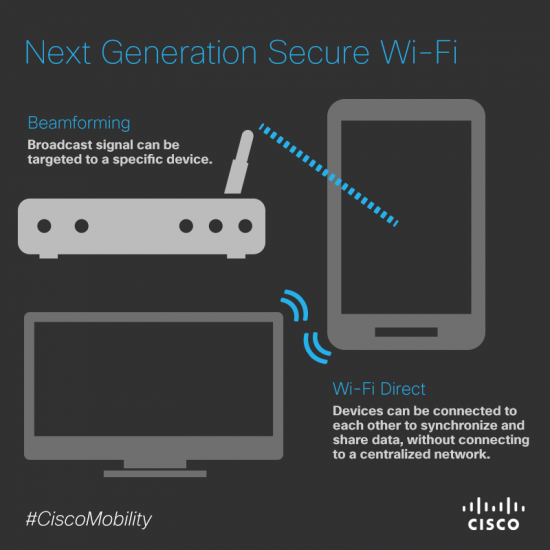With the adoption of the Internet of Things and Internet of Everything, advances in mobility and next-generation Wi-Fi are driving faster speeds, higher signal quality and more reliable connectivity. With the upcoming ratification of the two waves of the 802.11ac Wi-Fi standard, how are emerging Wi-Fi models creating new security features that are defining the next-generation Wi-Fi experience?
Next Generation Wi-Fi Models
Migration to the 5 GHz-only 802.11ac is quickly becoming a reality. In a recent article by Lisa Phifer, Chris Spain, Vice President of Product Marketing for Cisco’s Wireless Networking Group, discusses more about how this migration will drive a shift in mobile device support for 5 GHz. “An increasing percentage of new mobile devices provide dual-band capability, and they generally prefer the less congested 5 GHz band,” Spain said. New Wi-Fi models, like those listed below, can help drive mobile devices to the 5GHz band:
- Beamforming. It acts exactly like it sounds. Instead of a broadcasting a signal in a wide range, a signal can be targeted to a specific user or area. This type of Wi-Fi model can help improve wireless bandwidth utilization, and it can increase a wireless network’s range. In turn, beamforming can improve video streaming, voice quality, and other bandwidth- and latency-sensitive transmissions.
- Wi-Fi Direct. This emerging technology works a lot like Bluetooth. Objects can be connected to each other to synchronize, print or share data, without connecting to a centralized repository of connectivity. Because you can use the controller to configure the Wi-Fi Direct Client Policy, on a per WLAN basis, or disable Wi-Fi Direct Client Policy altogether, this type of technology is a secure way to enable the Internet of Everything to connect more people, processes, data and things.
The Value of Secure Wi-Fi
As more people connect to both wired and wireless networks via smart phones, tablets and laptops, security will continue to be a top concern. As mobility trends such as the proliferation of devices and increased data and video traffic drive new expectations from networks, a strategic and architectural approach to secure mobility is essential.
When next-gen Wi-Fi can deliver faster speeds and media-rich publishing platforms, the future of mobility can be better realized. For example, new revenue generating opportunities such as location-based services and marketing information can be delivered in a controlled and opt-in environment. Some examples include:
- Sensitive, real-time streaming information can be delivered to health professionals and first responders.
- Sports fans can shop for merchandise from their seats knowing that their credit card information is secure.
- Students studying at their local coffee shop can connect with their teachers and classmates, without having to sacrifice their afternoon latte.
This is the value of secure Wi-Fi, and increased mobility is making it possible. Be sure to download and read the Cisco 2013 Annual Security Report, which includes real-world data and analysis that can help you update and strengthen your security strategy.
How do you think mobility is driving the future of secure Wi-Fi networks? Let us know via comment below or join the conversation on Twitter, #CiscoMobility.



Mobility is growing fast but the majority still see WLANs as complementary to wired network access, and this is because of some security issues. In my opinion, I think this will need 2 years more, by 2016, to consider Wi-Fi as an alternative to wired networks.
But also, I would like to mention that in the near future all will be wireless, so that companies should be prepared.